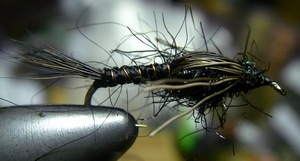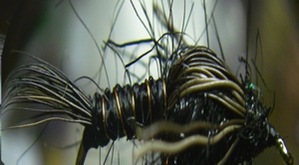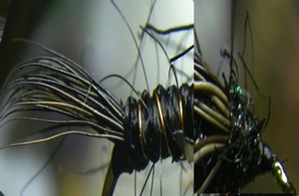I’ve always struggled with fish vision and how it fits with my imitation of prey. Like most anglers I’m probably too quick to declare fly tying “success” and my brief victory may be for all the wrong reasons.
It’s hard enough to get into a fish’s head, but to look out their eye compounds the issue a hundredfold. The only adequate simulation is to chug a fifth in a single draught, erasing 160 IQ and yielding “fish eye” vision – but doesn’t give adequate time to tie enough flies before the remedy is expelled violently.
We’re left to guess at what fish see and think.
Prevailing theory has all manner of interesting wrinkles that most fishermen should be aware of:

Development of receptors for “blue” are among the last grown in human children, and it’s suspected that more primitive eyeballs (fish) lack these receptors – and view the color differently.
Fish eyes are tuned to their prey, and the movement of a fleeing baitfish is seen better by a Striped Bass, than a smelt.
 Fish vision is not binocular, they must integrate two separate images of the same scene when looking to the front. There is a gap of missing information between the two images – as fish have eyes mounted on their sides and cannot see what’s in front of their nose.
Fish vision is not binocular, they must integrate two separate images of the same scene when looking to the front. There is a gap of missing information between the two images – as fish have eyes mounted on their sides and cannot see what’s in front of their nose.
 Fish eyes have evolved over many millions of years in a pristine environment, now the Man has “muddied the waters” vision is limited by turbidity, and fish diets are changing – from what they’re attuned for, to what they can see.
Fish eyes have evolved over many millions of years in a pristine environment, now the Man has “muddied the waters” vision is limited by turbidity, and fish diets are changing – from what they’re attuned for, to what they can see.
While it’s a struggle to resolve the scientific detail, and our laymen’s understanding of vision, this has to be one of the reasons why a #16 Royal Wulff catches fish during a Pale Olive hatch.
While the Royal Wulff doesn’t resemble a Pale Morning Dun, if it enters the right focal plane it might be missing the entire red floss center section, or the skewed visual of hackles obscure enough to make it resemble what’s hatching.
It’s food for thought certainly, and when you stop to consider some of these theories, how many well known mayflies and caddis are blue?
Flowers are color coded so that the best pollinator responds to its bloom, I’m sure similar holds for the balance of nature – it’s why we gaze in rapture at the pictures on the restaurant menu, then gaze in wonderment at the lifeless turd that arrives on our plate.
I’d describe myself as an impressionistic fly tier, I rarely use exacting imitations with knotted legs and painstaking detail, those flies work best on fishermen. I like simulation and movement rather than detail, and the precise proportions we’re taught to use are skewed by water quality and the perceptive limitations of our quarry.
It’s akin to reincarnation, everyone is someone famous in a past life, and we accredit fish with all the “smart” traits because they outwit us. If that holds water, it’s likely they’re victimized by flatulence and bad breath as well.
I’d guess that trout eat as many twigs and stems as mayflies, like humans they can’t all have perfect vision, and the older the fish gets the bigger its prey. Not because it’s “big fish big meal” – rather it can see the big meal clearly, and little stuff could be food, but often as not it’s debris.
Could be I’ve stumbled upon the reason why there’s so many discrete streams of air bubbles in the Little Stinking, and how the residents earned the “coarse fish” label. We’re so concerned about the methane released by cows – and we’ve overlooked the real culprit.

Interesting….very interesting.
with the new year, I find the wife and I are eating more and more twigs and stems…..come to think of it, my eyes have been moving towards the side of my head too!
And while we’re railing about fish/fishermen behavior, allow me to assault the monolithic view of fish behavior held by most anglers, who act as if fish are uniform in both act and nature – basically synchronized eating machines – which doesn’t account for natural variation among a population or even the odd fish that’s simply having an off day.
It’s like expecting the human race to all eat the same thing at the same time (an impossibility until slawdogs become universally available).
I have spoken.
We’re all going to be eating stems and twigs shortly.
All them dead mayflies that trout eat, isn’t it possible a fish can eat one that’s overly ripe?
Trapped in an eddy where it spins idly for 24 hours – baking in the hot sun…
I know what it’d do to me, and it ain’t pretty.
I think that Al Troth had it right in “Masters on the Nymph” when he spoke of taking a slide image of a fly and making it slightly out of focus to get an idea of what a trout sees in the stream. That seems reasonable to me and supports impressionism over realism. Having said that, wouldn’t you think that a sight feeder would have honed their visual skills to a point where it can identify food at a very high level? Afterall, they would have had time to do this over a long, long time.
I think all fish are sight feeders, I don’t think one fish can hown their vision better’n another via practice. A fish can have better vision than another via place in the food chain or superior genetics.
Humans mostly sight feed as well, some have better vision than others, but I can’t say a fellow that eats Colonel Saunders chicken every day sees that chicken better than someone who doesn’t.
Smell has to play a part as well. How else to explain the allure of chicken livers and rainbow-colored Power Bait?
You’re talking for humans, right?
No self respecting fish would eat that crap, would they?
I don’t buy it. While they are do not have binocular vision, they also are not stationary. The side to side motion trout have in a stream is not about just swimming against the current, they are also scanning with their eyes moving to see in totality objects to eat or run from. Regarding twigs and leaves, I’ve seen trout grab floating debris and spit it out once it is determined to be inedible, something people no longer seem to be able to do, i.e. mcnuggets, vending machine burritos, hoho’s…
HDW, you’re correct, fish are always on the move – the question becomes at what range do they spot a tidbit, and in that fateful moment they inhale it – what is their visual accuity?
They spot something at distance (unknown) move to intercept, and what is it they see when they decide to eat? They don’t swim around the nymph before inhaling it, they slide over in the current (eyeballing the food maybe with only a single eye) – then decide to eat or not.
With the chow directly in front of them, they cannot see the entire image – as shown above, so it’s likely they committed to the “eat” somewhere between spotting and inhaling prey.
Makes for some interesting cogitation.
KB, you forget out about the lateral line. That is one sense humans lack, and will never fully comprehend how it is physiologically perceived in fishes. The lateral line is likely the first sense responsible for feeding than sight. Also some other highly evolved fish [ like carp 😉 ] have developed barbels, and can taste food without even putting in their mouth. Look at the case of several catfish species who are blind or lack functioning eyes.
I agree with TC, there is way more to fish behavior than most anglers will give credit for. Hell, so much of fish behavior is unknown that even fisheries biologists are in the dark on much of it. It is the arrogance of anglers that type-cast a fish’s behavior and feeding habits. At best we can make an educated guess, and attempt to narrow down the possible scenarios in efforts to improve our success as an angler. Another brilliant nugget brought to light is the fact that no two fish individuals are the same, just like in humans. There may be trends within a school or population, but no two organisms will exhibit the exact same behaviors, under different scenarios, every time. There will be variance. It is just pure, simple physics. Look at chaos theory and equilibrium.
Just like predicting short range weather, we are merely looking for patterns, and try to match them as best as possible, in efforts to increase our success. I know this, because even the roughfisher is not immune from the occasional skunk.
There is no simple answer.
Good point, JPL – the lateral line is part of the answer. There’s an awful lot of blood-rich tissue behind it, and its use is still a partial mystery.
I’ve always assumed it was a “vibration sensor” – but that’s just an opinion, and far from factual.
What’s plain is that a tiny mayfly nymph can tumble down a fast current, and a trout with monocular vision can nail it unerringly. If they weren’t so equipped they’d have starved to death a couple million years ago.
A great topic, contentious and opinionated – and one that should be considered by all anglers.
A really good post. I love the “..victimized by flatulence and bad breath as well” bit.
I’m not sure I agree entirely about the monocular view. Not solely monocular anyway. A fly in front (and above probably) of them can be resolved very clearly because what each eye sees overlaps, apart from a small blind spot very close. This and the fact that a fish’s eyes stick out from the side of its head and many have grooves running from snout to eye aiding forward vision i think makes them see in a way similar to binocular vision even if the mechanics are not the same. Also it is interesting that the shape of a trout’s pupil (and even more in grayling) is not exactly spherical but a bit cone shaped. I have no idea how that affects vision but there must be an adaptive explanation for two drift feeders to have similar shaped pupils whereas something like a carp seems to have a more rounded pupil.
As for taking lots of twigs and stems, I am sure they do and wouldn’t be surprised if there is some learning going on there. But it would be pretty inefficient to take just as many non-food items as food. Too costly I think.
TU’s comment is a good one. Personalities (or the more cagey “temperaments”) in fish is getting a lot of attention from biologists at the moment.
Absolutely “a great topic, contentious and opinionated”.
Great stuff Keith.
Loved the post. Can I use this post for my Blog? Of course I will give the credit where credit is due. My blog is http://www.flyfishingfrenzy.com. let me know. thanks.
Hoss,
Feel free to use the post, friend
Keith, I know I’m coming at this a bit late, but if you haven’t seen it, you must grab a copy of The Underwater World of Trout, Vol. 2, “Feeding Lies” by Wendell “Ozzie” Ozefovich. It’s interesting to watch fish feed and what/how/where they take food. His narrating voice is a bit hard to listen to at first, but the content is incredible.
-scott c
Cutthroat: I’ll keep an eye out for a copy, thanks for the tip.